Last Friday was supposed to mark the end of our official 14-day quarantine, after our nightmare exodus out of coronavirus-stricken Norway. While Matthew and I have displayed none of the typical symptoms of COVID-19 (fever, cough), we have just learned that the exhaustion and intestinal troubles we endured later during our trip and at home may mean that we did indeed contract the disease.

Unfortunately, it seems that people who experience digestive problems as their primary symptom can transmit the virus longer, up to 40+ days. Which means we’re back to self-isolating for awhile. We can only hope that we’ve gotten off so lightly, with such a mild case, unlike many others who’ve not been as lucky.
Wouldn’t it be terrific if we could be tested for viral antibodies and know for certain that we now have immunity? I’m not holding my breath that such an option will be available anytime soon in Chicago. Conflicting information and a frightening shortage of tests and medical equipment across the U.S. makes it hard to feel safe.
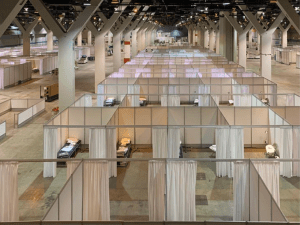
We’re fortunate that we live in Chicago, Illinois, where we have a truly admirable new governor and mayor, who took decisive action and implemented a shelter-in-place order earlier than most of the country. And through their efforts, things have moved forward quickly in building a new temporary Coronavirus hospital as Illinois’ numbers continue to soar. (Counting today, 13,549 infected, 380 dead.)

But still, Matthew and I question every day whether we made the right move in returning to the States, considering the Trump Administration’s schizophrenic response to the pandemic and the resulting rapid rise in infection rates. We often fantasize about what would have happened if we’d hidden ourselves away and ignored Norway’s eventual requirement that all foreigners return to their home countries. Deportation, probably. But let me back up for a minute to explain how we arrived at an international crossroads ….
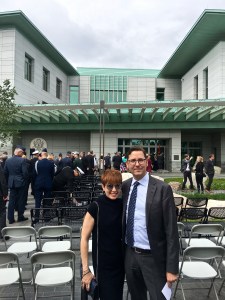
Many of you already know that we’ve been involved in a contract dispute with the U.S. government since our 2017 completion of the American Embassy in Oslo, where we lived for four years. In a nutshell, the U.S. State Department has not paid their final bills for the Embassy Campus construction. So it was in mid February that we headed back to Oslo for three weeks of legal depositions.
Given the looming pandemic and the fact that Matthew has a pre-existing health condition, we tried to postpone the trip. But the U.S. government seemed to have no concerns that they might place a considerable number of people at risk by demanding that the proceedings continue on their schedule.
Matthew and I tried to take comfort in the fact that, by the time of our flight, Norway had no known COVID cases. But a week after our arrival, the first case appeared in Tromsø — a woman who’d returned recently from China. By the middle of the following week, the infection rate began to rise rapidly as Norwegians returned from winter ski breaks in the mountains bordering Austria and northern Italy.

Why did Norwegians choose to vacation in a place with rampant coronavirus? Remember, Italy had only three registered cases by February 21, and Norway’s winter school break ran from February 17 – 21 this year. In essence, the outbreaks in Italy and Norway occurred almost simultaneously. No one could have predicted that Italy’s infection numbers would rocket to almost 1,000 just a little more than a week later.
By February 28, new sources reported that Oslo University Hospital in Ullevål had become a hotspot for rising infection rates in the city. An ophthalmologist at the eye clinic had returned from his Italian ski trip, then had gone back to work before later feeling ill and testing positive. He’d come into contact with more than 100 people, all of whom were traced and requested to practice self-quarantining at home.
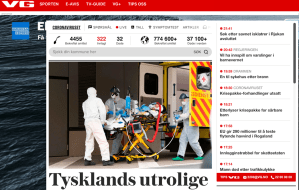
A week later, 63 people had been diagnosed across Norway, including five of the Ullevål eye doctor’s coworkers. I began to get nervous, obsessively refreshing the VG coronavirus website created to track the infection’s spread in Norway. And I tried to console myself that the numbers weren’t rising in Oslo’s center, where we were staying.
As the legal proceedings wrapped up, we squeezed in evening visits with friends, ever mindful of the suggestions that we opt for “elbow bumping” and “toe tapping” instead of hugging as a greeting. But many people expressed doubts about their countrymen’s ability to successfully follow epidemic protocols.
I heard more than one local voice fears that the disease would become rampant because, “Norwegians often feel it’s just better to get sick and get it over with. It’s common for people to socialize when they and their kids have fevers. It quickly spreads around the illness and speeds up the eventual immunity.” (Norwegians tend to take the Nietzschean ‘what-doesn’t-kill-you-makes-you-stronger’ approach to life.)

Another noted that “Norwegians like to joke that they always practice social distancing, since most would rather be alone in the woods. But add a little alcohol into the mix, and suddenly all social boundaries disappear. Ever notice how cozy people get on the Night Buses?”
One Norwegian friend joked, “We’re tough. We’ve survived multiple bubonic plagues in the past, we’ll survive this.” I didn’t have the heart to remind him that the Black Death killed off nearly two-thirds of Norway’s population in the Middle Ages, including the entire royal line. Which is why Denmark and later Sweden took over the country for about 400 years. Hmm, food for thought.
But despite dire predictions and Norwegian galgenhumor (“gallow’s humor”), people did seem to take the situation seriously. Restaurants, stores, and streets became eerily empty during our last weekend in Oslo. Officials limited the sacredly popular Holmenkollen ski festival to competitors only, no spectators. And yet still the numbers rose, to 400 by March 10, less than two weeks after the initial case.

To play it safe, we cancelled all further get-togethers and sat holed up in our hotel room until our departure date. We did try to move up our flight, but SAS advised us that changing our tickets so close to departure would be risky. Flights were being cancelled rapidly, and the airline couldn’t guarantee that we’d be assured of seats. So we hunkered down in front of the TV to wait and watch horrified as the news channels reported soaring numbers in Oslo and across Europe.
Two days later on March 12, the date of our flight, the country’s infection rate had doubled to 800. And Norway officially shut down. All schools, fitness centers, hair salons, etc., closed their doors, and all public gatherings and sporting events were cancelled. Most restaurants reverted to carry-out, and people were directed to shelter in place and work from home. Those taking public transportation were required to sit at least 1-2 meters apart.
Then came the news that if we didn’t make it back to Chicago on this last flight, we’d be denied entrance into the U.S. for 30 days. Unfortunately, the federal government didn’t make it clear that the policy would not apply to U.S. citizens. Unsurprisingly, chaos erupted.
Ours was one of the last flights out of the country; no incoming international flights were permitted thereafter. While our connecting flight to Stockholm was virtually empty, the plane to Chicago was packed with fleeing American vacationers, plus a few dozen Scandinavians temporarily living in the States.

Sadly, most of my fellow countrymen came off as completely clueless, coughing and sneezing without covering their mouths, and laughing and joking loudly about the virus. Finally one Scandinavian passenger yelled, “For god’s sake, this is not a joke. Sit down, cover your mouths when you cough, and stop talking so much and spreading your spittle all over everything!” A hostile Us-versus-Them mood quickly descended over the plane.
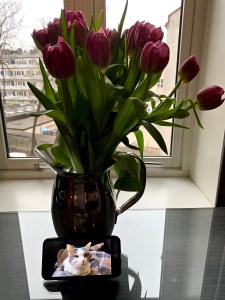
Fortunately, Matthew and I had come prepared for the occasion. Because our kitty Jess had been undergoing chemotherapy, we’d brought along masks, gloves, alcohol, and sterile wipes to clean her litter box after each treatment. So as soon as we sat down, I disinfected every square inch of our environment: seats, armrests, seat belts, magazine bins, TV monitors, and all sides of the tray tables. Plus we used hand sanitizer non-stop, even on our faces.
Being trapped for 10 hours on a plane full of potential coronavirus carriers was pure purgatory. But a deeper level of hell awaited us at Chicago’s O’Hare airport. Only one of the two Customs’ Bays was open, with a whopping five Passport Control officers on call. To put it impolitely, it was a total sh*t show.
We found ourselves stuck for almost three hours with passengers from Europe and Asia, all crowded together like cattle in a slaughter pen. Everyone touching those damn passport processing kiosks, and not a single bottle of hand sanitizer in sight. What better way to create a petri dish for a full-fledged outbreak?

When we finally made it up to the border agent, he never once mentioned the virus. No temperature check. No questions about whether we’d been experiencing symptoms. No concerns about whether we’d been exposed to any sick people having just come from a country on lockdown due to COVID. No mention of self-quarantines.
His only queries were how much we’d spent while in Norway, whether we’d accurately claimed all of our purchases, and whether we owed duty. Clearly our government’s biggest concern was cash flow, not containing a deadly contagion.
We arrived home late, after a tense cab ride with the windows down and a driver who refused to touch our luggage. Can’t say I blame him. Exhausted, we stripped down, showered, threw our clothes into the wash, and wrapped our suitcases in plastic until we had time to sterilize everything. And so began our official 14-day countdown to see if we’d somehow blessedly managed to get through our nightmare trip without contracting the virus.
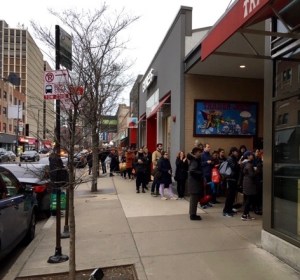
The next morning, we headed to the grocery store, since we needed to replenish our kitchen after being away so long. No such luck. The shelves of our local Trader Joe’s were virtually empty. We snagged a few random veggies, but the only proteins available were the most expensive — tuna steaks and filet mignon. No egg, milk, butter, flour or butter to be had.
The following morning we joined a line that stretched down and around the block, with everyone hoping to take advantage of a newly arrived shipment. We scored a few more essentials, but the amount of crowding inside the store reminded me of our Customs experience. No social distancing whatsoever.


Since then, I’ve tried every grocery store within walking distance of our condo. I’ve ordered online for delivery (a five-day wait), and attempted store pickup (a three-day wait). Even with this last option, I sat in the parking lot for two hours while the personal shopper tried to find substitutions for out-of-stock items. And in the end, I had to assist the shopper in the aisles to speed things up.
Every time I go inside a mobbed store, I completely mask up, including gloves, glasses, and a hood. And I carry a bag of hand sanitizer and Lysol wipes so I can clean anything I touch. People laugh, jeer, and crowd close — until I yell, “I just got back from Europe; you’re gonna wanna stay six feet away!” Then most people startle and run like rats caught in the headlights.
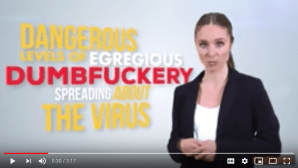
But some have foolish, even aggressive responses to my warning. One woman with a doctor’s white coat draped over her arm (but wearing no personal protective gear) harrumphed, “I’m in healthcare!,” as if that made her invincible. Another young girl responded, “Whatever. It’s just gonna kill all you old people anyway, and good riddance.”
Selfishness and stupidity about the virus abounds here in the U.S., but that’s no big surprise, considering the federal response to the situation. What else can you expect from the general public in a country led by a president who:
- Spends weeks denying the severity of the virus; and then blames everyone else for the problem;
- Disseminates inaccurate information regarding testing, vaccines, potential treatments, and overall preparedness;
- Places the economy and his re-election campaign above the value of human life;
- Leaves governors and mayors to determine protective measures haphazardly rather than developing a national plan;
- Drags his feet on ramping up and regulating the production and distribution of vital medical equipment, which has led to shortages, price hikes, and bidding wars between states;
- Denies aid to governors and states that criticize federal efforts and “don’t show appreciation.”

When we compare Norway’s response to that of the U.S., it’s hard not to feel regretful that we had to leave. For example, the amount of time elapsed between Norway’s first COVID case and its nationwide shelter-in-place order? Just 17 days. As a result, the initial spike in cases has slowed dramatically, with 5,903 registered infections overall, and only 89 deaths thus far.
The time elapsed since the U.S.’s initial COVID case and a nationwide shelter-in-place order? Currently 77 days and counting. Which is why the U.S. now holds the top spot as the country with the most number of infections. Just in the last 17 days, we’ve gone from 19,367 cases to 390,387 cases — more than one quarter of the number of infections worldwide — and with 12,474 deaths.

It’s also hard not to compare Trump’s daily broadcasts — filled with self promotion, insults, contradictions, and misinformation — to those of Prime Minister Erna Solberg and King Harald. Norway’s prime minister held a half-hour press conference with kids to answer their questions truthfully about coronavirus. And an excerpt from the king’s speech reveals the essence of how Norwegian society responds during a crisis:
“We find ourselves in a situation that is unreal, alien and frightening for all of us. We do not recognise our everyday life or the world around us. And yet we are only standing at the beginning of something we do not fully know the consequences of.
Uncertainty makes us vulnerable. The seriousness makes us anxious. The new everyday life can give us a feeling of powerlessness. Norway is affected along with the rest of the world. Now our most important task is to try to slow down the dramatic development, by following the orders given by the authorities.

We can be grateful that we have political leaders and professional medical authorities with the courage and knowledge to deal with the situation with honesty and realism. Norway is known as a society based on trust.
Now there is a special need to show each other trust. Both to ensure that everyone takes responsibility for preventing the spread of infection. And for the country’s authorities to make good and wise decisions.
My thoughts and prayers are with you all now. With you who are sick and with you who are relatives of the sick. My thoughts and prayers are with health professionals all over the country, day and night. With those who are experiencing financial loss and fear for the future. To all of you who hold important social responsibilities so that our country can function.
My thoughts and prayers are with all the children – who may be particularly anxious now – and whom we must take extra care of. And with those who feel the loneliness because our small and large communities are temporarily taken away from us.
Finally, I would like to remind you that everyone needs some extra kindness during this time. Together we stand, and together we will be able to get through what lies ahead.”
That’s the kind of verbiage you should expect from a leader. And if you managed to get through that speech without tearing up, kudos to you, you must already be dead inside. JK 😉

Anyway, that’s not to say that there haven’t been hiccups in Norwegian prevention measures. Like New Yorkers, who’ve fled to their second homes in rural locations, many Norwegians ran for their hytter (“mountain cabins”). The prime minister ordered everyone back to their primary residences to avoid overwhelming small-town health centers with COVID cases. But unlike in the U.S., Norwegian offenders who were slow to respond and refused to follow quarantine measures got slapped with a fine and / or jail time.

Norway also has its fair share of COVIDiots, like teens from my home state of Kentucky who hosted a coronavirus party, apparently believing that being young and stupid also made them immortal. Yet when a young Norwegian tested positive and then attended a big private party, he didn’t just get free publicity for his reckless behavior — he had to pay a fine of 20,000 NOK (about $1,900 USD) or spend 40 days in prison. Ouch, that’s really going to put a dent in his beer money.
While we’re on the topic of money (since that seems to be Trump’s focus), let’s just compare how the two nations mitigate the virus’s financial impact on their citizens.
Unemployment Compensation
Norway offers extraordinary support for the unemployed during the COVID lockdown. Everyone who is unable to work due to the shelter-at-home order collects their full salary throughout the government-mandated period, which is currently 20 working days. The employer pays two days of this salary, the remainder comes from the Norwegian government.
If a company must lay off employees longer than the government-ordered shutdown, employees who make less than $28,302 USD (300,000 NOK) per year receive 80% of their salaries. Employees who make up to $56,000 USD (600,000 NOK) receive 62.4% of their salary. And that’s for 260 working days (52 weeks — essentially a full year.)
Compare that with U.S. unemployment compensation. It varies by state based on income level, but the average unemployment check nationwide is $400 per week ($20,800 USD/year, which is 220,480 NOK/year). It’s paid for only 26 weeks (six months). Remember that the poverty threshold for an American family of four is $25,750 USD (272,950 NOK). The recent COVID federal relief package increases this amount by $600 USD (6,360 NOK) per week, but for only four months.
Sick Leave
Norwegian employees on regular sick leave receive 100 % of their income, of which the employer pays for the first 16 days. Then the government takes over the payments for the next year (260 working days). If an illness is due to COVID, the employer’s responsibility is reduced to only 3 days, and the government picks up the tab thereafter.
Norwegians also normally receive 10 days of paid sick leave per parent to care for a sick child. During COVID, Norway has added an additional ten days of paid sick leave per parent to care for children affected by school closures. This, too, is paid for entirely by the government, not the employer.
In the U.S., the average American gets 7 paid sick days per year, which includes taking time off to care for a sick child. If you or your child is sick longer than that, you can use vacation time (typically ten paid days per year in the U.S.) Or you can take unpaid Family Medical Leave, which simply forces your employer to hold your job for 12 weeks.
During the COVID pandemic, the new Families First Coronavirus Response Act (FFCRA) extends coverage by providing employees with two weeks of paid sick leave. Family Medical Leave has been extended to cover 12 weeks of paid leave, but at only two-thirds of an employee’s salary level, with a maximum amount of $200 USD per day. (2,120 NOK).

Healthcare & Insurance
Speaking of being sick, in Norway, healthcare for children under 16 is free. Once an adult meets the annual out-of-pocket deductible of 2,040 NOK ($193 USD), all medical treatment is free, including emergency room visits. Medical coverage is paid for by the government, not the employer. And there’s no fee for COVID testing. Which totally makes sense, if a nation wants to halt the spread of the virus and ensure that those who are infected are identified quickly and isolated.
In contrast, here in the U.S., healthcare is expensive. In 2019, the average insurance cost per family was $20,576 USD (218,105 NOK). A family’s typical out-of-pocket expenses amounted to $6,015 USD (63,759 NOK), with the remainder being paid by the employer. Consequently, in 2018 alone, there were nearly 28 million non-elderly uninsured Americans.

In the U.S., COVID testing is paid for according to each patient’s insurance plan and deductibles. The FFCRA mentioned above gives states the option to extend Medicaid coverage for uninsured people to include COVID diagnosis and testing with free federal financing. However, the Medicaid extension does not cover medical treatment of an infected, non-insured person.

Taxation
Yes, the average Norwegian pays 40 – 45% in taxes, but you can see that they get quite a lot of financial security for their money. And that’s not counting state-supported higher education, child care, elder care, living-wage retirement pensions, and a mandated five weeks of vacation. Plus well-maintained infrastructure like public transportation, roads, bridges and a huge range of citizen services.
Here in the U.S., significant tax cuts given in recent years by the Trump Administration to corporations and the top 1% of wealthy Americans have severely hampered cash flow. And the promise that an economic boom will make up the deficit has not proven true, and certainly will not materialize now. It remains unclear how the federal government will recoup it’s 2.2 trillion-dollar COVID Relief Stimulus Package. That’s a big debt for a nation already burdened by federal deficit of $23 trillion.
We’ll see if the next election changes anything. My guess is that by the time November rolls around, many of the people who support the current administration may no longer be registered voters. Areas that have been Trump strongholds — the impoverished American south, rural communities, and states with a disproportionate share of elderly — will be hardest hit by the coronavirus and will have the fewest resources available for recovery.
I only hope that the death rate will slow by autumn. If not, I fear that continued chaos will provide an excuse to postpone or cancel the presidential election, especially if it seems that popular support for Trump has waned or died off.
And on that anxious note, I’ll close out one of my darkest posts yet and promise that the next one will be a bit more lighthearted.


Thank you for sharing your experiences, Kimberly. This may prove to be your most important post, as it documents so well this particular moment in time, from both a European and US perspective. I am so sorry to learn of Jess’ death, as well as all the anxious, stressful time you had in your travel to Norway and return to the US in the midst of this pandemic. I hope that you and Matthew will stay well. Please keep in touch! Warmest regards from Mary Ann
LikeLike
Hi Mary Ann! Thank you so much for your kind words; I really appreciate it 🙂 Yes, it has been an unbelievable time all around the world; I’m sure none of us ever thought we’d live through such times. I do hope you and your family are doing well and have not gotten sick. Look like Denmark is keeping their numbers low, thank goodness. Matthew and I send you warm and healing vibes, and we hope that we can reconnect in person soon!
LikeLike
Wishing you both well. I’d love to schedule a call to catch up. I’m at 214-406-2150. Let me know if you can find a time to visit. In the meantime, hope you’re both hanging in there!
Love, Jolie
Sent from my iPhone
>
LikeLike
Hi Jolie — it’s so great to hear from you! We’d love to catch up! I’ll text you with potential times as soon as Matthew is out of his conference calls. Hope you guys are doing well, too! Love, K.
LikeLike
Hard-hitting lines during this hard and challenging times… Can see what’s filling your thoughts.
Must mention that my love and respect for Norway and it’s untiring care for the citizens has really doubled after reading your post.
Stay strong and stay safe!
LikeLike
Yep, Norway has handled the pandemic impressively, without a doubt. As of today (May 13, 2020), the country has had only 8,168 coronavirus cases. The infection rate has slowed in the last week to less than 30 new infections per day, with a per capita of 1,570 cases per million, with only 229 dead so far. Just 16 people remain on ventilators.
Wish I could say the same for Chicago, Illinois, which has roughly the same population count as Norway (around 5.2 million). Here, we’ve had 36,668 infections and 1,673 deaths (that’s a per capita of 7,050 cases per 1M people), with 750 people on ventilators as of yesterday. And in Illinois overall, we’ve had 83,000+ infections and 3,600+ dead so far. Today’s count hasn’t yet come in.
Norway began re-opening gradually three weeks ago when their numbers dropped to less than 100 infections per day due to their successful nationwide shutdown. Their economy is rapidly getting back on track because everyone buckled down, followed instructions, and stopped the spread quickly.
By comparison, as Chicagoans continue to ignore orders about wearing masks and sheltering in place, our numbers continue to rise (4,000+ yesterday alone). End result is that the citywide shutdown is likely to be extended through July, further tanking an already abysmal economy.
And Trump has stated that Illinois will receive no federal assistance, although Chicago has the third largest GDP in the US, and Illinois as a whole has the fifth largest. Yeah, Trump is clearly a crack businessman who cares about restoring the economy.
It’s a rough ride here. But I’m counting my blessings that Matthew and I are healthy and still employed (so far). Hope you stay safe and healthy as well!
LikeLike
I stumbled across your blog researching an upcoming trip to Norway, and got hooked: I read from beginning to end! I loved reading about your adventures all over Europe, and I hope you are doing well in this “post” COVID world we are all struggling to navigate.
LikeLike
Hi Hanna–I’m so thrilled that you’ve enjoyed my blog! And I hope it helped provide you with useful info for planning your time in Norway. It’s truly wonderful to finally be able to travel again, and to such a gorgeous country! Did you have a good trip?
I’m sorry I took so long to reply to your comment. At the time you wrote, I’d just come down with Covid despite two vaccinations, a booster, and perpetual masking, and I got behind on many things in life. Luckily I had a mild case (merely a fever and a head cold, which has caused some ongoing sinus issues. Argh.)
In any case, I’m relieved to be rendered immune from the virus for a few months, and just in time…because I’m beyond overjoyed to be heading back to Norway in a few weeks! I’ll finally be able to write about some new sites we plan to visit (like the Lofoten Islands), so stay tuned for more stories soon. As they say in Norway, Ha det bra! (Have a good one.)
LikeLike
Thanks for your response! We just got back from our trip, which was unforgettable and wonderful…and terrible as well because we both caught COVID (probably before we left, but we will never know for sure). But we visited Oslo, Bergen, and Balestrand and absolutely loved Norway and the people. I look forward to reading more from you in the future!
LikeLike